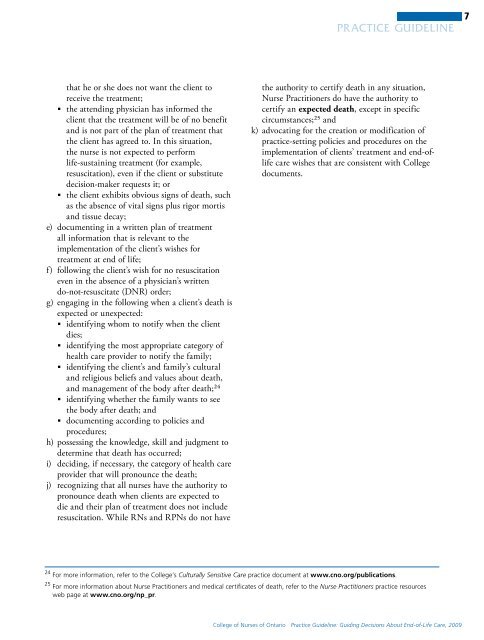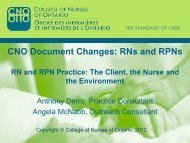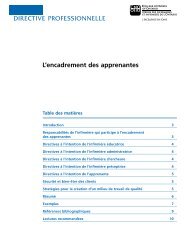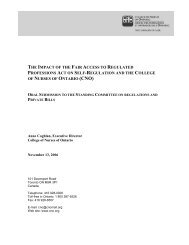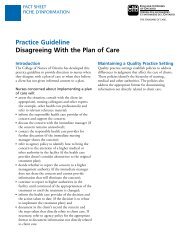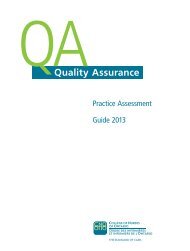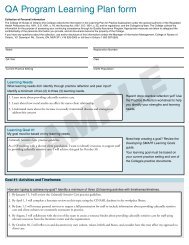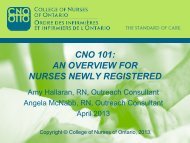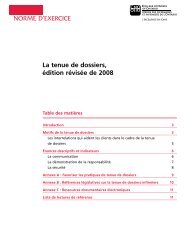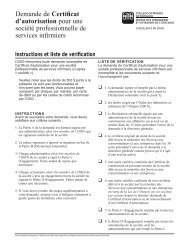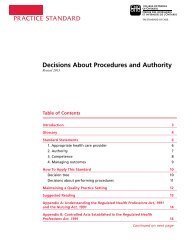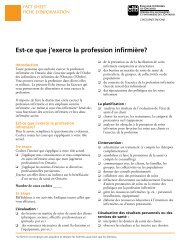6Practice Guidelineand/or end-<strong>of</strong>-life care issues. (For example, anurse could present a client situation during ateam meeting or rounds or include an ethicist onthe care team, if it is appropriate);h) knowing the end-<strong>of</strong>-life care wishes <strong>of</strong> the clientor obtaining that knowledge from:■the client’s direct instructions (which includenon-verbal means);■the client’s advance directive (such as a livingwill or power <strong>of</strong> attorney for personal care);■the substitute decision-maker’s instructions,if the client is incapable; or■documented instructions from anothermember <strong>of</strong> the health care team;i) explaining the client’s wishes to all members <strong>of</strong>the interpr<strong>of</strong>essional care team;j) maintaining records20 <strong>of</strong> client andinterpr<strong>of</strong>essional team communicationsabout treatment and end-<strong>of</strong>-life care decisionsaccording to organizational policies andprocedures as well as the <strong>College</strong>’s Documentationpractice document;k) contributing to ongoing communication aboutend-<strong>of</strong>-life care wishes and implementing theclient’s wishes by:■reviewing the client’s plan <strong>of</strong> treatmentincluding resuscitation wishes as needed orwhen required by organizational policy. (Forexample, in long-term care settings, the reviewcould be part <strong>of</strong> the regular client healthreview);■documenting the relevant information; and■communicating any changes in client’s wishesto the interpr<strong>of</strong>essional team and ensuring thewishes are included in the plan <strong>of</strong> treatment;andl) advocating for the creation or modification<strong>of</strong> practice-setting policies and procedures tosupport client choices during treatment and end<strong>of</strong>-lifecare, based on <strong>College</strong> documents.Implementation<strong>Nurses</strong> advocate for the client and help implementthe client’s treatment and end-<strong>of</strong>-life care wishes.<strong>Nurses</strong> implement a client’s treatment and end-<strong>of</strong>lifecare wishes by:a) ensuring that the creation <strong>of</strong> the plan <strong>of</strong>treatment has involved both the interpr<strong>of</strong>essionalteam and the client, and that the client has giveninformed consent for the plan <strong>of</strong> treatmentbefore implementation;b) acting on behalf <strong>of</strong> the client to help clarify theplans for treatment when:■the client’s condition has changed and it maybe necessary to modify a previous decision;■the nurse is concerned the client may nothave been informed <strong>of</strong> all elements in theplan <strong>of</strong> treatment, including the provision orwithholding <strong>of</strong> treatment;21■the nurse disagrees with the physician’s plan <strong>of</strong>treatment;22 and■the client’s family disagrees with the client’sexpressed treatment wishes;23c) initiating treatment when:■the client’s wish for treatment is knownthrough a plan <strong>of</strong> treatment and informedconsent;■the client’s wish is not known, but a substitutedecision-maker has provided informed consentfor treatment; or■it is an emergency situation, there is noinformation about the client’s wish, and asubstitute decision-maker is not immediatelyavailable;d) not initiating treatment that is not in the plan <strong>of</strong>treatment, except in emergency situations, when:■the client has not given informed consent,and/or the plan <strong>of</strong> treatment does not addressreceiving the treatment;■the incapable client’s wish is not known, andthe substitute decision-maker has indicated20 For more information, refer to the <strong>College</strong>’s Documentation, Revised 2008 practice document at www.cno.org/publications.21 For more information, refer to the <strong>College</strong>’s Consent practice document at www.cno.org/publications.22 For more information, refer to the <strong>College</strong>’s Disagreeing with the Plan <strong>of</strong> <strong>Care</strong> practice document at www.cno.org/publications.23 For more information, refer to the <strong>College</strong>’s Conflict Prevention and Management practice document at www.cno.org/publications.<strong>College</strong> <strong>of</strong> <strong>Nurses</strong> <strong>of</strong> Ontario Practice Guideline: <strong>Guiding</strong> <strong>Decisions</strong> <strong>About</strong> <strong>End</strong>-<strong>of</strong>-<strong>Life</strong> <strong>Care</strong>, <strong>2009</strong>
Practice Guideline7that he or she does not want the client toreceive the treatment;■the attending physician has informed theclient that the treatment will be <strong>of</strong> no benefitand is not part <strong>of</strong> the plan <strong>of</strong> treatment thatthe client has agreed to. In this situation,the nurse is not expected to performlife-sustaining treatment (for example,resuscitation), even if the client or substitutedecision-maker requests it; or■the client exhibits obvious signs <strong>of</strong> death, suchas the absence <strong>of</strong> vital signs plus rigor mortisand tissue decay;e) documenting in a written plan <strong>of</strong> treatmentall information that is relevant to theimplementation <strong>of</strong> the client’s wishes fortreatment at end <strong>of</strong> life;f) following the client’s wish for no resuscitationeven in the absence <strong>of</strong> a physician’s writtendo-not-resuscitate (DNR) order;g) engaging in the following when a client’s death isexpected or unexpected:■identifying whom to notify when the clientdies;■identifying the most appropriate category <strong>of</strong>health care provider to notify the family;■identifying the client’s and family’s culturaland religious beliefs and values about death,and management <strong>of</strong> the body after death;24■identifying whether the family wants to seethe body after death; and■documenting according to policies andprocedures;h) possessing the knowledge, skill and judgment todetermine that death has occurred;i) deciding, if necessary, the category <strong>of</strong> health careprovider that will pronounce the death;j) recognizing that all nurses have the authority topronounce death when clients are expected todie and their plan <strong>of</strong> treatment does not includeresuscitation. While RNs and RPNs do not havethe authority to certify death in any situation,Nurse Practitioners do have the authority tocertify an expected death, except in specificcircumstances;25 andk) advocating for the creation or modification <strong>of</strong>practice-setting policies and procedures on theimplementation <strong>of</strong> clients’ treatment and end-<strong>of</strong>lifecare wishes that are consistent with <strong>College</strong>documents.24 For more information, refer to the <strong>College</strong>’s Culturally Sensitive <strong>Care</strong> practice document at www.cno.org/publications.25 For more information about Nurse Practitioners and medical certificates <strong>of</strong> death, refer to the Nurse Practitioners practice resourcesweb page at www.cno.org/np_pr.<strong>College</strong> <strong>of</strong> <strong>Nurses</strong> <strong>of</strong> Ontario Practice Guideline: <strong>Guiding</strong> <strong>Decisions</strong> <strong>About</strong> <strong>End</strong>-<strong>of</strong>-<strong>Life</strong> <strong>Care</strong>, <strong>2009</strong>


